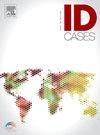When herpes zoster is not herpes: A case of statin-induced myopathy complicated by drug allergies
IF 1
Q4 INFECTIOUS DISEASES
引用次数: 0
Abstract
Statins are commonly prescribed to reduce cardiovascular risk, but statin-induced myopathy is a leading cause for therapy discontinuation. This case report discusses a 69-year-old female with multiple comorbidities, including smoldering multiple myeloma, who presented with myalgias and a vesicular rash initially suspected to be herpes zoster due to her immunocompromised status. Elevated creatine kinase (CK) levels were noted (>9000 U/L) while the patient was on high-dose atorvastatin. Despite initial suspicions of herpes zoster, the rash’s atypical progression led to further evaluation, revealing a more complex picture. The patient had a significant history of drug allergies, complicating the diagnosis, particularly following recent clindamycin treatment for a dental issue. After discontinuing atorvastatin and clindamycin, her CK levels improved, and subsequent testing confirmed the presence of anti-HMG-CoA reductase antibodies, establishing a diagnosis of statin-induced autoimmune necrotizing myopathy. This case underscores the importance of detailed patient histories and the need to consider drug-induced hypersensitivity reactions in immunocompromised individuals. The resolution of symptoms after stopping the offending medications emphasizes the critical role of careful monitoring and diagnosis in managing patients with complex medical backgrounds.
当带状疱疹不是疱疹:他汀类药物引起的肌病合并药物过敏1例
他汀类药物通常用于降低心血管风险,但他汀类药物诱发的肌病是导致停药的主要原因。本病例报告讨论了一名患有多种合并症的69岁女性,包括阴燃型多发性骨髓瘤,由于免疫功能低下,她表现为肌痛和水疱疹,最初怀疑是带状疱疹。患者服用大剂量阿托伐他汀时,肌酸激酶(CK)水平升高(>9000 U/L)。尽管最初怀疑是带状疱疹,但皮疹的非典型进展导致了进一步的评估,揭示了更复杂的情况。患者有明显的药物过敏史,使诊断复杂化,特别是在最近用克林霉素治疗牙齿问题之后。停用阿托伐他汀和克林霉素后,她的CK水平有所改善,随后的检测证实存在抗hmg - coa还原酶抗体,诊断为他汀类药物诱导的自身免疫性坏死性肌病。该病例强调了详细的患者病史的重要性,以及考虑免疫功能低下个体药物引起的超敏反应的必要性。停止违规药物后症状的解决强调了仔细监测和诊断在管理具有复杂医学背景的患者中的关键作用。
本文章由计算机程序翻译,如有差异,请以英文原文为准。
求助全文
约1分钟内获得全文
求助全文

 求助内容:
求助内容: 应助结果提醒方式:
应助结果提醒方式:


